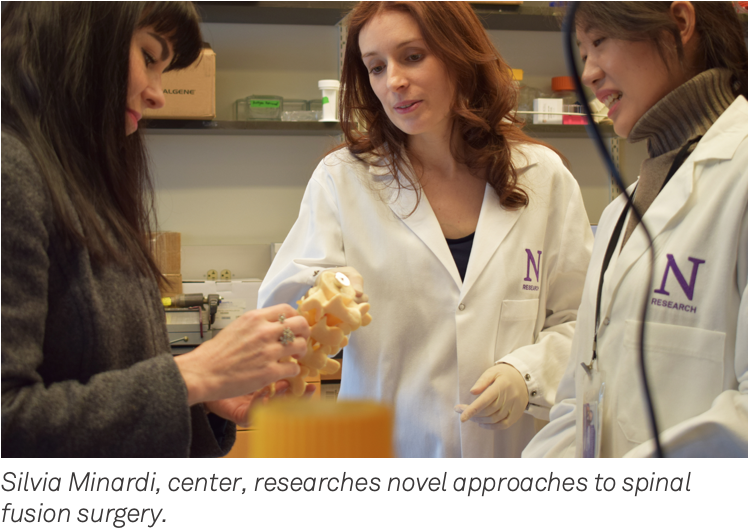Meet the Faculty: Silvia Minardi
Silvia Minardi joined the SQI faculty in 2019 as a Research Assistant Professor of Orthopaedic Surgery. In her ongoing collaborations with SQI members Erin and Wellington Hsu, Minardi is exploring novel techniques for bone regeneration, with a focus on spine fusion.
Minardi earned a PhD in Regenerative Nanomedicine from the University of Bologna (Italy) in 2015 and came to Northwestern University in 2016 as a postdoctoral researcher. She has published more than 30 research articles and textbook chapters, and recently presented a talk titled “How to Grow Bone” at the Rising Stars of SQI Lecture.
Read the interview below to learn more about Minardi and her research.
When did you first become interested in science?

In high school I had a very good science teacher that got me interested. I started to find humanities a bit boring and decided they weren’t for me. So, I started leaning more toward math and biology and chemistry, in particular. Then I started going to a few universities and looking around. I also went to visit one of the branches of the National Research Council of Italy, which was close to where I was going to school. I talked to some scientists there and I just loved the laboratories.
How did you get connected with the Hsu Lab and begin collaborating with them?
My love for research started very early on. I started as a summer intern in a bone lab during college, and I’ve never left bone.
For a brief time in the Northwestern Department of Medicine, I was working in kidney research, but kidneys and bones are actually very interconnected, so that was just a brief deviation.
Bone is my first love and that’s where I want my career to be.
How would you explain your current research projects to a non-scientific audience?
We are developing innovative strategies that rely on chemistry, engineering, biology and medicine to develop solutions for patients in the orthopaedic space, in particular for spine surgery.
I know that your recent lecture was titled “How to Grow Bone”. Is there one approach that you are focused on right now or do you have several projects with this same goal?
There are several different ones. Because I’m a faculty member, I am involved in most of our lab’s projects, either by overseeing the daily operations or performing experiments. In collaboration with other SQI groups like the Stupp Lab, the Rivnay Lab and the Hersam Lab, we’re currently trying to approach spinal fusion with multiple types of nanostructured and 3D-printed materials.
Our main preclinical model is a spinal fusion model, but most of these materials could definitely be applied in other areas of orthopaedics.
How could these approaches ultimately benefit patients?
When we’re speaking about spinal fusion, we are trying to utilize lower doses of growth factors, which come along with a lot of side effects. We are also looking to utilize nonbiologic materials to prevent the need for bone autografting, since bone graft harvest can be painful for the patient and can require multiple surgical sites.
We’re trying to streamline and simplify some of these surgeries, which will definitely improve the outcome and postoperative care for the patient.
How far along is this research?
We have a little bit of everything, so we have some projects where we are developing pilot studies and still doing basic research. But we have a few projects in which we have initiated the large animal studies that are needed for FDA approval, so in those we are definitely closer to the clinic.
What do you find the most rewarding about your career?
The idea that you are doing something that will have an impact on people’s lives, and also just the advancement of science and technology. The ability to train future scientists and physicians is another reason why I like to perform research in a university.
What do you enjoy doing outside of the lab?
I like traveling, spending time with my family and just enjoying the city.
I love the architecture and I love Lake Michigan. There are beautiful cruises that you can take with the boat tours, and I also like watching live music. I would say summer is definitely my favorite time to be in Chicago.
